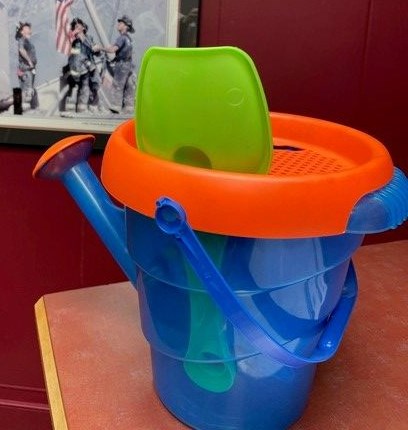Bond Building and Blitz Programs
It’s relationship and experience and not shop size that allows the Enterprise Mold team to tackle some nontraditional mold projects—at least they are nontraditional for the shop’s Windsor location.

For this sprinkler can, the customer wanted a two-cavity plastic injection mold instead of the usual blow mold used for these types of toys, and Fred Durfy agrees because plastic injection molding is less expensive, lengthens mold life and produces a better product. Photo credit: Enterprise Mold.
Launched in 1986 with three partners, Fred Durfy is working on his 36th year with Enterprise Mold in Windsor, Ontario, focusing on toys, sporting goods, and some medical equipment. Lacrosse helmets, rollerblades, full face shields, and a sprinkler can are among the products Durfy highlighted for me.
The sprinkler can project arose from a conversation around the table with Durfy’s longtime customer. “When we finished a small sprinkler can project, we thought that it would be great if we could make a bigger can to put toy accessories in and sell as a package,” Durfy says. “And off we went much as we do for all of our blitz programs where we flood the market with the product immediately to beat the global competition.”

An effort like this—where the size of the mold package and the aggressive lead times require everyone on the project to move at lightning speed—depends on communication and trust, which can only come from building relationships with your customers.
The whole Enterprise team brings a wealth of experience and craftsmanship to each customer, providing necessary technical support. Durfy himself has 50 years of experience in moldmaking.
When it comes to technology Enterprise’s CAD/CAM department uses the latest in hardware and software technology. “Engineering receives customer data and quickly produces accurate, precise designs and surface data using CADKEYs. Once designs and surface data have been checked and approved, information is then sent to our CNC department where cutter paths are generated using WorkNC software. Once completed the data is sent directly to the machine,” Durfy explains.
From CNC boring mills to a fully equipped EDM department, along with the finishing room, spotting presses and quality control, Enterprise designs and builds quality tools.
An effort like this—where the size of the mold package and the aggressive lead times require everyone on the project to move at lightning speed—depends on communication and trust, which can only come from building relationships with your customers.
For the sprinkler can, customer ownership and engineers requested a two-cavity plastic injection mold instead of the usual blow mold that many competitors use for these types of toys. “Plastic injection molding is cheaper, makes a structurally better product, and provides more UV protection. Plus, the mold lasts longer because it is more consistent with wall stock,” Durfy says.
Durfy admits there were some learning curves and necessary changes, especially with the processing end of the project, such as appropriate cycle times and using 100% virgin material.
Durfy needed to educate the customer on running a quality part. For example, the benefits of going slower and having no scrap. “Slow down, and make the tool last a little longer; you won’t have to run it twice,” Durfy says.
Related Content
-
Leading Mold Manufacturers Share Best Practices for Improving Efficiency
Precise Tooling Solutions, X-Cell Tool and Mold, M&M Tool and Mold, Ameritech Die & Mold, and Cavalier Tool & Manufacturing, sit down for a fast-paced Q&A focused on strategies for improving efficiencies across their operations.
-
MMT Chats: Solving Schedule and Capacity Challenges With ERP
For this MMT Chat, my guests hail from Omega Tool of Menomonee Falls, Wisconsin, who share their journey with using enterprise resource planning (ERP)—and their people—to solve their schedule and capacity load monitoring challenges.
-
The Role of Social Media in Manufacturing
Charles Daniels CFO of Wepco Plastics shares insights on the role of social media in manufacturing, how to improve the “business” side of a small mold shop and continually developing culture.













.jpg;maxWidth=300;quality=90)


.jpg;maxWidth=970;quality=90)